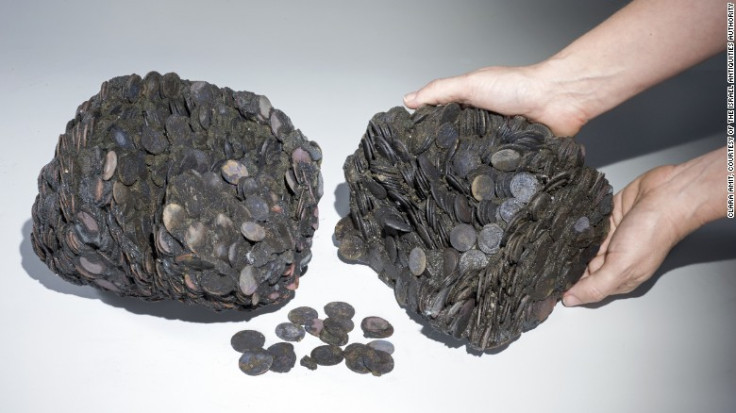Treasure trove of coins and bronze statues recovered from 1,600-year-old Roman shipwreck near Israel
Divers have discovered thousands of coins and precious fragments of life-size bronze statues in the ancient harbour of Caesarea off the Mediterranean coast. The Israel Antiques Authority (IAA) said the artefacts are in an "amazing state" of preservation as they were buried in layers of sand.
The haul has been described as Israel's most significant find of Roman artefacts for three decades. Many of the objects are extraordinarily well preserved, according to the IAA. They include a bronze lamp depicting the image of the sun god Sol, a figurine of the moon goddess Luna and a lamp in the image of the head of an African slave.
One of the biggest surprises was the discovery of two metallic lumps composed of thousands of coins weighing around 20 kilograms, which still kept the shape of the pottery vessel in which they were transported.
According to Jacob Sharvit, director of the Marine Archaeology Unit of the Israel Antiquities Authority and Dror Planer, deputy director of the unit, "these are extremely exciting finds, which apart from their extraordinary beauty, are of historical significance.

"The location and distribution of the ancient finds on the seabed indicate that a large merchant ship was carrying a cargo of metal slated for recycling, which apparently encountered a storm at the entrance to the harbour and drifted until it smashed into the seawall and the rocks".
A preliminary study of the iron anchors suggests there was an attempt to stop the ship before it reached shore by casting anchors into the sea. However, these broke, demonstrating the immense power of the waves and the wind.
"The sand protected the statues; consequently they are in an amazing state of preservation – as though they were cast yesterday rather than 1,600 years ago".
The coins discovered have the image of the emperor Constantine who ruled the Western Roman Empire (312–324 CE) and was later known as Constantine the Great, ruler of the Roman Empire (324–337 CE). There are also coins bearing the likeness of Licinius, an emperor who ruled the eastern part of the Roman Empire and was a rival of Constantine. Licinius was eventually defeated in a battle between the two Roman rulers.
"I dive here every other weekend and I never found anything like that ever," said Ofer Raanan, one of the divers who made the first discovery in April. The remains of the ship were "left uncovered on the sea bottom". What has excited archaeologists the most is that the haul of bronze statues of this shipwreck is much greater than those of previous excavations.
Experts believe that the merchant ship was carrying the metal goods to an unknown site where it would be recycled. Metal statues of the classical era are very rare as they were often melted down and reused as material for other items.
According Sharvit and Planer, "The range of finds recovered from the sea reflects the large volume of trade and the status of Caesarea's harbour during this time, which was known as a period of economic and commercial stability in the wake of the stability of the Roman Empire."
© Copyright IBTimes 2025. All rights reserved.






















